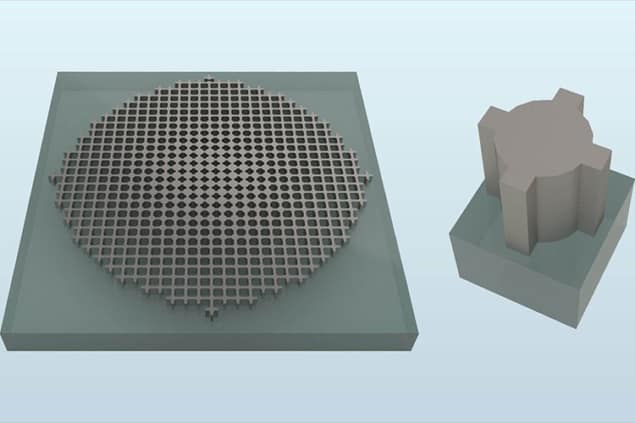
A new type of metasurface lens developed by US researchers is far less susceptible to optical dispersion than previous designs – which means that it can focus a wider range of wavelengths more efficiently. Boubacar Kanté of the University of California, Berkeley and colleagues believe their new lens could find a range applications including hi-tech medical imaging, energy harvesting and virtual reality.
Optical dispersion occurs when the refractive index of a medium varies with the light’s wavelength. One of its most visible manifestations is chromatic aberration in a lens: the lens has a shorter focal length for wavelengths for which its refractive index is higher, resulting in a blurred image. Since dispersion was first explained by Isaac Newton in 1660, people have developed ways to mitigate it. One involves achromatic doublet lenses, comprising two lenses with different refractive indices stuck together such that the dispersion of one roughly compensates the dispersion of the other.
Today, however, optical technology is moving away from traditional lenses and towards flat optical metasurfaces. These are thinner and lighter and offer functionalities such as reconfigurability and variation of refractive index with polarization that are impossible to achieve with traditional lenses. However, there are difficulties associated with metasurfaces – and among the most prominent are increased chromatic aberration and other performance variations with wavelength.
Wavelength independence needed
The principal cause of these problems is that, whereas bulk lenses control light through cumulative effects on the waves passing through, metasurfaces use optical elements to interact with the wavefronts directly and tailor their shape and phase. To achieve this interaction, these optical elements comprise structures on the scale of the wavelength of the light they control. Variations in the wavelength therefore significantly affect this interaction. Moreover, many of the most efficient metasurface designs are based on resonators, which have a sharp peak at one wavelength: “If you want to make a laser, you want one colour, so a resonant cavity is perfect,” explains Kanté, “But if you want to make a lens, one colour is not good enough!”
In the new work, Kanté and colleagues took a different approach. Instead of using resonators, they used a “fishnet” structure – a lattice of interconnected 350 nm titanium dioxide grids spaced 370 nm apart. Each element behaves as a waveguide: “You need to make those little waveguides as broadband as possible,” explains Kanté. Waveguide-based metasurfaces have been designed before, but they have invariably had efficiencies well below those of the current design. However, the researchers had another, subtler trick up their sleeves.
The phase of each waveguide must be carefully selected to produce a surface with maximum possible efficiency. Previously, researchers have selected the phase of each waveguide independently, by assuming it to be part of a lattice of identical waveguides. “When I make my lens, the waveguide next to it is different,” explains Kanté, “but I assume that it’s not that different, so the error that I get by assuming that it’s the same is not that big.” In 2017, however, Kanté and colleagues showed that this is simply inadequate. They also presented a method for calculating the correct phase. In their latest research, they used this to select the orientation of each pillar in the lattice. The resulting lens focused at least 70% of incident light in the wavelength range 640-1200 nm to the same point.
Fluorescence imaging
The researchers believe that, if a scalable production process can be developed, their design could perform a range of tasks, such as producing virtual reality images and focusing light in solar cells – a process that helps harvest energy more efficiently. “If you are now comparable in efficiency [with traditional lenses] the next question becomes ‘how large scale can you make these things and how much do they cost?’” says Kanté. Even without large-scale production, however, Kanté believes the lenses could contribute to techniques such as fluorescence imaging, which is a Nobel-prize winning super-resolution microscopy technique now widely used in research and medicine: “You pump the molecules with one colour and they emit at another,” explains Kanté, “Now that our lenses are broadband, you could actually pump and collect with the same ultrathin lens.”
Metasurface-based contact lens corrects colour blindness
Francesco Monticone of Cornell University is impressed “While several recent papers have proposed a large variety of design methods to realize broadband achromatic metasurfaces – with some impressive results…the experimental demonstration and measurements presented [by Kanté’s team] are outstanding.” Monticone’s group recently published fundamental limits on the bandwidth of optical metalenses: “The fabricated metalenses [made by Kanté’s team] represent an important step toward reaching these physical bounds, extending the current state of the art of metalenses and their potential for many applications requiring broad bandwidth and high efficiency,” he says.
The metalenses are described in Nature Communications.



